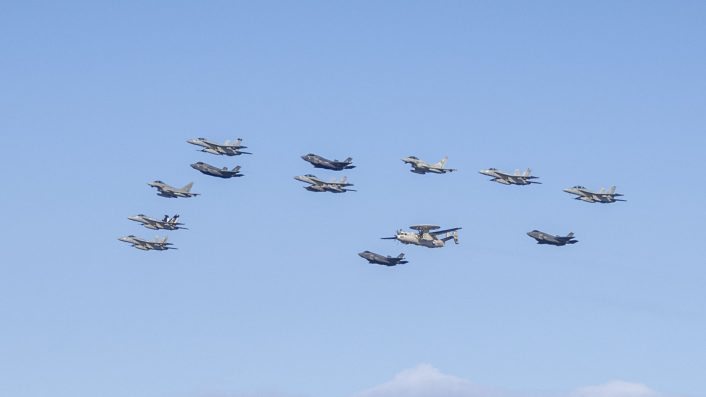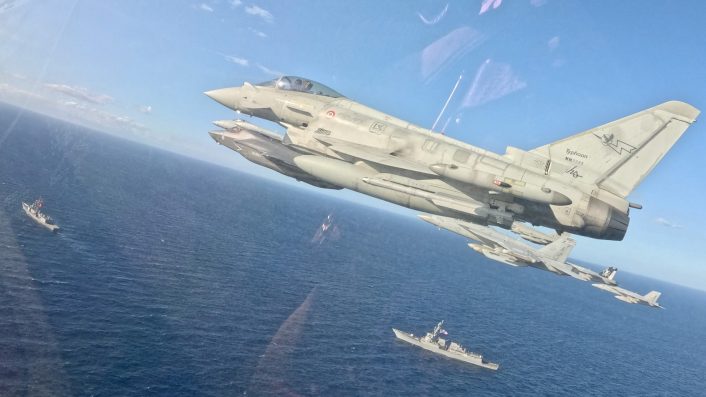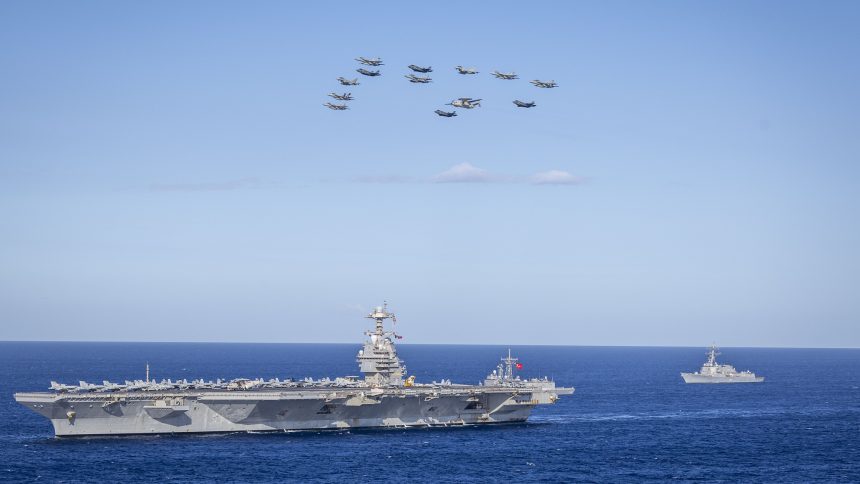U.S. F/A-18Fs and Italian F-35Bs conducted simulated CAS operations over the Black Sea and into Romanian training areas during NATO’s Neptune Strike 25-2.
As the USS Gerald R. Ford (CVN 78) and its Carrier Strike Group (CSG) sail in the Mediterranean Sea, U.S. Navy F/A-18F Super Hornets and Italian F-35B Lightning IIs conducted simulated close-air support operations over the Black Sea and into Romanian training areas during NATO’s premiere enhanced Vigilance Activity, Neptune Strike 25-2. The training activity was announced by NATO’s Allied Joint Force Command (JFC) Naples in a post on social media.
The JFC stated these activities reinforce NATO’s presence in the Black Sea Region and demonstrate force projection capabilities from the Mediterranean Sea in coordination with NATO’s Black Sea Nations. At the same time, it emphasized that these missions were conducted in international airspace and in accordance with international laws.
Maintaining Presence
🇺🇸U.S. F/A-18F Super Hornets and 🇮🇹Italian F-35B Lighting II Fighter Jets✈️ under the authority of NATO, with aerial refueling support of an U.S. KC-130 Multi-Role Tanker, conducted simulated close-air support operations over the Black Sea and into Romanian… pic.twitter.com/kGyjljBzLQ
— NATO JFC Naples (@JFC_Naples) August 1, 2025
Other than the F/A-18s and F-35s, a U.S. KC-130 also supported the mission providing aerial refueling support. No photos and videos have been released about this mission, and the video included in the X post is from activities of the previous days with U.S. F/A-18Es, E-2Ds, KC-46s, Portuguese F-16s and Finnish F/A-18s.
Topping off! ⛽
1️⃣ A Carrier Air Wing 8 F/A-18E Super Hornet attached to Strike Fighter Squadron 37 flies over a T-058 Royal Netherlands Air Force Multi-Role Tanker Transport aircraft and two Finnish Air Force F-18s flying in formation. 🇺🇸🇳🇱🇫🇮
2️⃣ Super Hornets conduct an… pic.twitter.com/Nr9uOrbz4I
— U.S. Navy (@USNavy) July 29, 2025
Neptune Strike 25-2 and Ford CSG
The Ford CSG arrived in the Mediterranean in mid-July and joined Neptune Strike 25-2, which will see the CSG and supporting Allied nations conducting long-range strike missions across NATO’s areas of operations to include the Baltic and Black Sea Region. In fact, few days earlier, U.S. F/A-18Es also operated together with Finnish F/A-18Cs an Portuguese F-16s over the Baltic Sea and Lithuania.
“Gerald R. Ford Carrier Strike Group’s participation in Neptune Strike enhanced vigilance activity strengthens our Alliance’s collective resolve, readiness, and operational integration capabilities under NATO command,” said Rear Adm. Paul Lanzilotta, commander of Carrier Strike Group Twelve. “This activity provides the framework for purposeful multinational maritime integration, and is a clear expression of our continued commitment to the defense of the Alliance, peace, and regional security and stability.”

In a statement, NATO said the Neptune Strike series is a long-planned vigilance activity, which is deliberately planned and dynamically executed in support of NATO’s deterrence objectives, guided and directed by NATO’s Supreme Allied Headquarters Europe (SHAPE). In total, 14 Allied Nations are taking part in the maneuvers, which are defined as defensive, over the entire Europe: Croatia, Finland, France, Germany, Greece, Italy, Lithuania, Norway, Poland, Romania, Spain, Slovakia, the United Kingdom, and the United States.
“Our Neptune Strike enhanced vigilance activities represent important opportunities to coordinate and employ a wide range of combat forces throughout the European theater and demonstrate our combined capability to respond to crises and provide collective defense to the Alliance,” said Vice Adm. J.T. Anderson, commander of STRIKFORNATO. “This reaffirms our continued commitment to high-end warfighting excellence as well as the unity of the Alliance.”
The USS Gerald R. Ford, along with the nine embarked squadrons of Carrier Air Wing Eight, Destroyer Squadron Two’s Bainbridge and USS Mahan (DDG 72), and USS Winston S. Churchill (DDG 81), left Virginia in June, transiting the Strait of Gibraltar on July 19, 2025. Carrier Strike Group Twelve is on scheduled deployment in the U.S. 6th Fleet area of operations, where it will continue to work alongside NATO Allies and other partners, focusing on strengthening partnerships, deepening interoperability, and supporting theater security and stability.

Joint operations
As testimony of these joint operations, an Air and Sea Formation took place in the Adriatic Sea on July 29, 2025. Italian and U.S. aircraft conducted a flypast over the USS Gerald R. Ford (CVN 78), which was accompanied by Italian Navy ITS Rimini (M 5561), Turkish Navy TCG Gelibolu (F-493), and Arleigh Burke-class guided-missile destroyers USS Bainbridge (DDG 96), USS Winston S. Churchill (DDG 81), and USS Mahan (DDG 72).
Allied ships and aircraft from 🇮🇹🇹🇷🇺🇸 come together in perfect formation as #STRIKFORNATO 🔱 takes command and control of the USS Gerald R. Ford, the largest and most advanced aircraft carrier in the world, and its formidable Carrier Strike Group as part of #NeptuneStrike 🔱. pic.twitter.com/ZeibXkjL2j
— STRIKFORNATO (@STRIKFORNATO) July 30, 2025
Among the U.S. aircraft involved were almost all types employed by Carrier Air Wing Eight: F/A-18E/F Super Hornets, an EA-18G Growler and an E-2D Hawkeye. Italy deployed F-35B Lightning IIs of the Navy, as well as F-35A Lightning IIs and F-2000A Typhoons of the Air Force.









